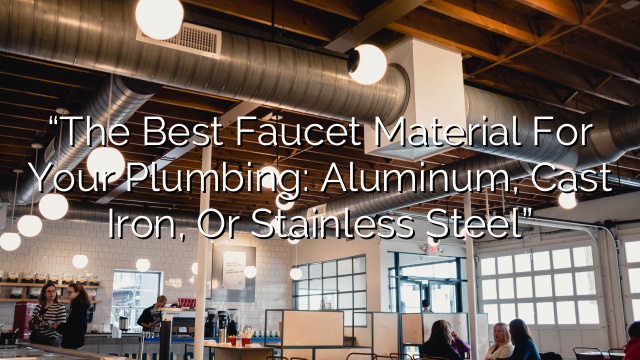When it comes to plumbing fixtures, faucets and flush valves are two essential components that we all encounter in our daily lives. Whether it’s in our homes, offices, or public spaces, these fixtures play a crucial role in providing convenience and functionality. In this blog post, we’ll explore the basics of faucets and flush valves, their functions, types, and maintenance tips.
Understanding Faucets
A faucet is a device that controls the flow of water from a pipe or container. It consists of various components, including handles, spouts, cartridges, and aerators. The primary function of a faucet is to regulate the flow of hot and cold water and control its temperature.
There are several types of faucets available in the market, including:
- Compression faucets: These faucets have separate handles for hot and cold water. They work by compressing a rubber washer against a valve seat to stop the water flow. However, the rubber washer may wear out over time and lead to leaks. Regular maintenance is required to prevent such issues.
- Ball faucets: Ball faucets have a single handle that controls both hot and cold water flow. They use a rotating ball to regulate the water flow and temperature. These faucets are relatively durable and require minimal maintenance.
- Cartridge faucets: Cartridge faucets use a cartridge to control the water flow and temperature. They have a single handle and are generally easy to operate. These faucets are known for their excellent performance and longevity.
- Disc faucets: Disc faucets use two ceramic discs to control the water flow and temperature. They are considered one of the most reliable types of faucets in terms of durability and performance.
Understanding Flush Valves
A flush valve is a mechanism that controls the flow of water entering a toilet bowl or urinal. It is responsible for clearing the waste and maintaining hygiene in the bathroom. Flush valves are commonly found in public restrooms, commercial buildings, and some residential properties.
There are mainly two types of flush valves:
- Gravity flush valves: These valves use the force of gravity to flush the waste. When the flush handle is pressed, the water stored in the toilet tank is released into the bowl, creating a siphon effect that removes the waste. Gravity flush valves are simple, reliable, and require minimal maintenance.
- Pressure-assist flush valves: Pressure-assist flush valves use compressed air or water pressure to flush the waste. When the flush handle is pressed, the pressurized water forcefully enters the bowl, removing the waste more efficiently. These valves are commonly used in commercial settings and places with high foot traffic.
Maintenance Tips for Faucets
To ensure the longevity and optimal performance of your faucets, consider following these maintenance tips:
- Regular cleaning: Clean your faucets regularly to remove dirt, grime, and mineral deposits. Use a mild cleaning solution and a soft cloth to avoid scratching the surface.
- Check for leaks: Periodically check your faucets for any leaks. Fixing leaks promptly can prevent wastage of water and minimize potential damages.
- Replace worn-out parts: If you notice any worn-out parts, such as washers or cartridges, replace them immediately to prevent leaks and ensure smooth operation.
- Check water pressure: High water pressure can damage your faucets over time. Consider installing a pressure regulator to maintain the optimal water pressure.
Maintenance Tips for Flush Valves
Keep your flush valves in top condition with these simple maintenance tips:
- Clean the valve: Regularly clean the flush valve to remove debris and mineral deposits that may affect its performance. Use a brush and a mild cleaning solution to clean the valve thoroughly.
- Check the flapper: The flapper is an essential component of a flush valve. Inspect it regularly for any signs of wear or damage. Replace the flapper if necessary to maintain a proper seal.
- Adjust the water level: Ensure that the water level in the tank is adjusted correctly. Too much or too little water can affect the flushing performance. Consult the manufacturer’s guidelines for proper adjustment.
- Test the flush: Periodically test the flush to ensure that it is working correctly. If you notice any issues, such as weak flushing or incomplete clearing of waste, consider contacting a professional plumber for assistance.
FAQs
- How often should I replace my faucet? The lifespan of a faucet can vary depending on its quality and usage. However, most faucets can last for 10-15 years with proper maintenance. If your faucet is constantly leaking or experiencing other issues, it may be time for a replacement.
- Can I install a new faucet myself? If you have basic plumbing knowledge and the necessary tools, you may be able to install a new faucet yourself. However, it is recommended to hire a professional plumber for the installation to ensure proper connections and avoid any potential leaks or damages.
- How often should I replace the flapper in my flush valve? The flapper in a flush valve may need replacement every 2-5 years, depending on its condition and usage. If you notice any leaks or issues with the flushing performance, it is advisable to replace the flapper.
- Why is the water pressure in my faucet low? Low water pressure in faucets can be caused by various factors, including clogged aerators, sediment buildup, or issues with the water supply. Cleaning or replacing the aerator, flushing the water supply lines, or contacting your water provider can help resolve the issue.
- Can I use a pressure-assist flush valve in my home? While pressure-assist flush valves are commonly used in commercial settings, they can also be installed in homes. However, due to their higher water consumption and noise levels, they may not be suitable for every household. Consider consulting a professional plumber to determine the best flush valve option for your home.







